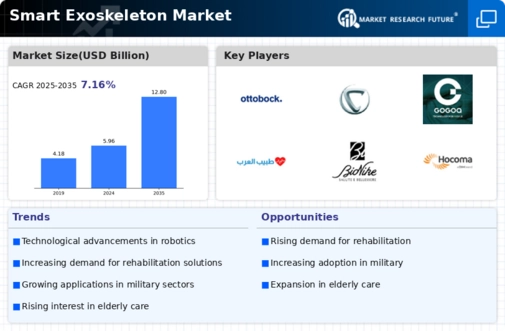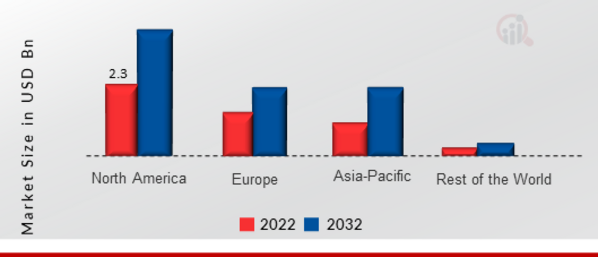Market Share
Introduction: Navigating the Competitive Landscape of Smart Exoskeletons
The smart exoskeleton market is experiencing an unprecedented level of competition, driven by the fast adoption of new technology, regulatory changes, and increasing consumer expectations for enhanced mobility solutions. The main players, including original equipment manufacturers, IT service companies, and emerging smart technology companies, are competing to establish leadership in the market, utilizing advanced capabilities such as machine learning, IoT, and biometrics to create differentiated solutions. The original equipment manufacturers are focusing on the development of mature products and the establishment of strategic alliances, while the IT service companies are enhancing system interoperability to gain market share. Emerging smart technology companies are introducing green solutions and sustainable practices, which appeal to the growing number of eco-conscious consumers. The trend of deploying individualized exoskeletons to meet the diverse needs of consumers is increasing as opportunities for growth expand, particularly in North America and Asia-Pacific. The rapid changes in the smart exoskeleton market require a deep understanding of the technology and the competitive landscape to be able to effectively compete in the market.
Competitive Positioning
Full-Suite Integrators
These vendors offer comprehensive solutions integrating hardware and software for various applications.
| Vendor | Competitive Edge | Solution Focus | Regional Focus |
|---|---|---|---|
| Ekso Bionics Holdings Inc. | Pioneering exoskeleton technology | Medical rehabilitation and industrial applications | North America, Europe |
| ReWalk Robotics | Focus on spinal cord injury rehabilitation | Medical exoskeletons for mobility | North America, Europe, Asia |
| Lockheed Martin Corporation | Defense and aerospace expertise | Military and industrial exoskeletons | North America, global defense markets |
| Parker Hannifin Corp. | Strong industrial automation background | Industrial exoskeletons for worker support | North America, Europe, Asia |
Specialized Technology Vendors
These companies focus on niche applications or specific technologies within the exoskeleton market.
| Vendor | Competitive Edge | Solution Focus | Regional Focus |
|---|---|---|---|
| CYBERDYNE Inc. | Innovative hybrid assistive technology | Medical and rehabilitation exoskeletons | Japan, global markets |
| DIH Technologies Corporation | Advanced robotics integration | Industrial and medical exoskeletons | China, Asia |
| Rex Bionics Ltd. | Focus on user-friendly designs | Rehabilitation exoskeletons | UK, Europe |
| US Bionics | Innovative design and engineering | Assistive exoskeletons for mobility | North America |
| BIONIK | Focus on neurorehabilitation | Medical exoskeletons for therapy | North America, Europe |
Infrastructure & Equipment Providers
These vendors provide essential components and systems that support exoskeleton technology.
| Vendor | Competitive Edge | Solution Focus | Regional Focus |
|---|---|---|---|
| Hyundai Motor Company | Automotive engineering expertise | Robotic exoskeletons for mobility | South Korea, global markets |
| Gogoa.eu | Focus on lightweight designs | Wearable exoskeletons for rehabilitation | Europe |
| ATOUN Inc. | Innovative wearable robotics | Industrial exoskeletons for labor support | Japan, Asia |
| RB3D | Customizable exoskeleton solutions | Industrial applications | France, Europe |
| Sarcos Corp. | Focus on heavy-duty applications | Industrial exoskeletons for enhanced strength | North America |
| Wearable Robotics SRL | Focus on rehabilitation and assistance | Wearable robotic solutions | Italy, Europe |
| Technaid SL | Specialized in rehabilitation technology | Medical exoskeletons for therapy | Spain, Europe |
| Hocoma | Leader in rehabilitation solutions | Therapeutic exoskeletons | Switzerland, global markets |
| Focal Meditech | Focus on assistive technology | Rehabilitation exoskeletons | Netherlands, Europe |
| B-TEMIA Inc. | Focus on mobility enhancement | Wearable exoskeletons for rehabilitation | Canada, North America |
Emerging Players & Regional Champions
- Ekso Bionics (USA): Specializes in exoskeletons for rehabilitation and industrial applications, recently partnered with major rehabilitation centers to enhance patient mobility, challenging established vendors by offering more affordable solutions.
- - ReWalk (Israel) - Exoskeletons for people with spinal cord injuries, recently signed contracts with hospitals in Europe for clinical trials, complementing the existing suppliers of equipment with a new, personal and individualized solution.
- SuitX (USA): Offers modular exoskeletons for industrial applications, recently implemented solutions in manufacturing sectors, challenging traditional vendors by providing customizable options that enhance worker productivity.
- Cyberdyne (Japan): Known for its HAL (Hybrid Assistive Limb) technology, recently expanded its market presence in Asia with government contracts for elderly care, complementing established vendors by focusing on elder care and rehabilitation.
- Parker Hannifin (USA): Develops exoskeletons for industrial and military applications, recently collaborated with defense contractors for military exoskeletons, challenging established vendors by integrating advanced robotics and AI.
Regional Trends: In 2024, the global Smart Exoskeleton Market is set to witness substantial regional growth, particularly in North America and Europe, as a result of the technological advancements in rehabilitation and the rising demand in industrial sectors. The trend towards customizing and modifying the products to suit the end-users’ needs is also expected to be a prominent one. Besides, Asia-Pacific is also expected to witness substantial growth, owing to the growing focus on the integration of exoskeletons in the national healthcare system.
Collaborations & M&A Movements
- Ekso Bionics and Lockheed Martin entered a partnership to develop advanced military exoskeletons aimed at enhancing soldier performance and reducing fatigue, thereby strengthening their competitive positioning in the defense sector.
- ReWalk Robotics acquired the assets of the startup ATOUN in early 2024 to expand its product offerings in the rehabilitation exoskeleton market, enhancing its market share and technological capabilities.
- Skeletal Dynamics and the University of California, Berkeley announced a collaboration to research and develop next-generation exoskeletons for industrial applications, aiming to improve worker safety and productivity in manufacturing.
Competitive Summary Table
| Capability | Leading Players | Remarks |
|---|---|---|
| Biometric Self-Boarding | Ekso Bionics, ReWalk Robotics | Ekso Bionics has incorporated biometric sensors into their prosthesis, which facilitates the identification of the patient and thereby enhances the security and efficiency of the rehabilitation process. The ReWalk® robot has been successfully used in clinical trials, and has proven to improve patient outcomes. |
| AI-Powered Ops Mgmt | Cyberdyne, SuitX | Cyberdyne's HAL exoskeleton is a tele-operated robot that can learn the movements of the operator in real time and thus improve the efficiency of the industrial process. SuitX's AI-based exoskeleton management system is a management system that automatically optimizes the performance of exoskeletons according to the feedback from the operator and the environment. |
| Border Control | Sarcos Robotics, Lockheed Martin | The Sarcos company has supplied exoskeletons for the personnel of the border control, thus increasing their physical capabilities. The Lockheed Martin exoskeletons are designed for the military, giving soldiers more strength and endurance for border patrols. |
| Sustainability | Bionik Laboratories, Parker Hannifin | Bionik Laboratories is a company that manufactures exoskeletons and specializes in the use of eco-friendly materials. The exoskeletons are energy-efficient, reducing the energy needed to operate them and thus reducing energy consumption. |
| Passenger Experience | Honda, Toyota | Honda’s Walking Assist Technology Improves the Public Transport Experience for Everyone. The new exoskeleton is designed for personal mobility, providing the wearer with a comfortable and easy way to move around in crowded places. |
Conclusion: Navigating the Smart Exoskeleton Landscape
The Smart Exoskeleton Market is characterized by a highly fragmented and highly competitive nature, with a number of companies, both established and new, vying for a share of the market. Among the key geographical trends is the rising demand in North America and Europe, which is driven by the growth in the medical and industrial applications. Artificial intelligence, automation, and flexibility are emerging as the key capabilities to drive the market. The established players are focusing on enhancing their technology offerings and integrating sustainable practices, while the new players are focusing on capturing niche segments. Strategic leaders must invest in these key capabilities to gain a competitive advantage and long-term success.










Leave a Comment